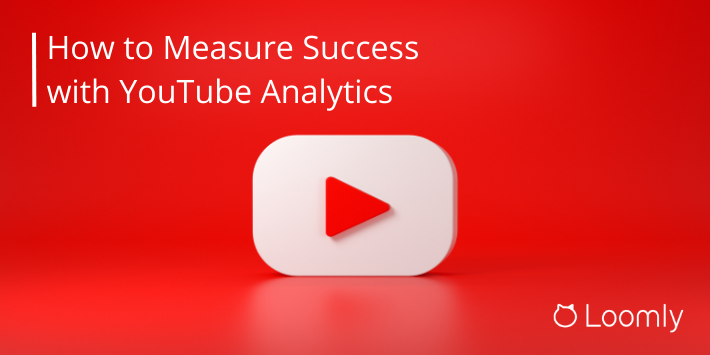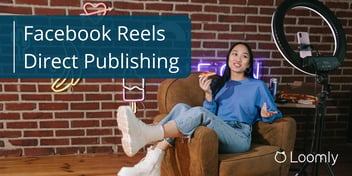While YouTube doesn’t pay you when you get likes (if only!), they’re still valuable currency, however, they’re only one aspect of YouTube Analytics.
Likes help improve your YouTube content’s visibility. Which means more eyeballs on it, and, hopefully, more ad revenue and sales. Plus, they instantly tell you whether your content is hitting the mark or falling flatter than a 2 day-old pancake.
But, aside from seeing the overall number of likes on a given video, is it possible to dig deeper so you can learn more about your audience? Can you see the individual users who liked a specific video or comment?
Let’s find out.
Before we get started, did you know that you can create, preview, approve and publish videos to YouTube, just like with all other channels supported by Loomly?
Learn how to schedule and publish videos to YouTube with Loomly here.

Manage all your social media accounts in one place.
Craft, schedule, & auto-post content to all your social channels, then track analytics and manage interactions from a single, easy-to-use dashboard.
Can you see who liked your YouTube video or comments?
Unfortunately, the answer is that, no, it isn’t possible to see which specific user has liked a video or comment. The same goes for dislikes.
There’s lots of speculation as to why this is the case, but it’s just that. Speculation. YouTube has never explained its reasons.
The good news is that you don’t need to study every single user who has liked a video or comment to glean useful insights into your audience. In addition to the overall number of likes (and dislikes) on a video or comment, you can access a plethora of valuable data by selecting Analytics, then Audience in your YouTube Studio dashboard:
- The number of unique viewers
- The number of returning viewers
- A breakdown of your viewers by age, gender, and geographic location
- What other videos and channels they watch — useful for understanding what your audience likes and as a source of inspiration
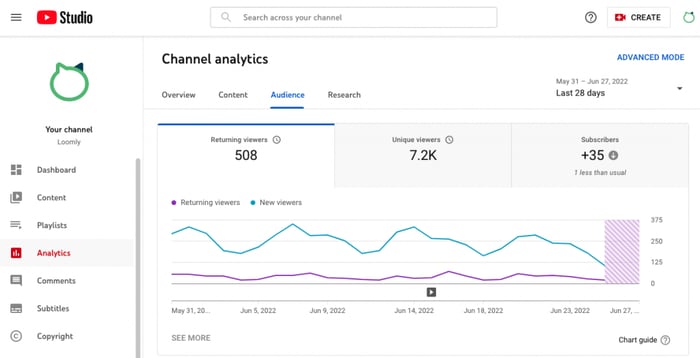
While likes are important, they’re not the be-all-end-all metric to look at when using YouTube Analytics to measure your content’s performance.
How important are YouTube likes, anyway?
Research shows there’s a clear correlation between the number of likes and a video’s position in YouTube’s search results. Videos with more likes generally tend to rank better than similar videos with fewer likes.
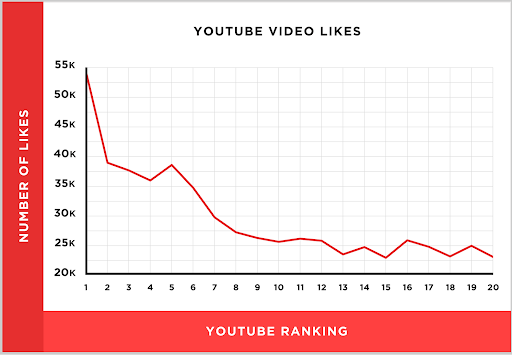
Source: Backlinko
That said, YouTube’s algorithm prioritizes the videos that have the most engagement for a given search query. And while likes are tangible proof that people have, in fact, engaged with your content — and that said content is worth watching — they’re only one small piece of the engagement puzzle.
So what other factors influence engagement and, in turn, how well your content ranks in search? We’ll give you four:
1. YouTube Audience Retention
YouTube’s biggest priority is for users to stay on the site for as long as possible (shocker!). So you won’t be surprised to hear that audience retention — the average length of time users spend watching a video — has a big impact on search rankings.
The higher your audience retention stats, the better your content’s chances of ranking well.
To put this in YouTube’s own words, the algorithm is primed to reward “videos that keep viewers watching.” Videos with consistently high audience retention, YouTube continues, “have the potential to show up more frequently in Search.”
You can evaluate audience retention by looking at your channel’s Key Moments for Audience Retention report. This will show you where you got it right — including the parts of your video where views spiked — and where you’re losing viewers’ attention.
To pull the report:
- Log on to your YouTube Studio dashboard
- Choose ‘Content’ from the menu on your left
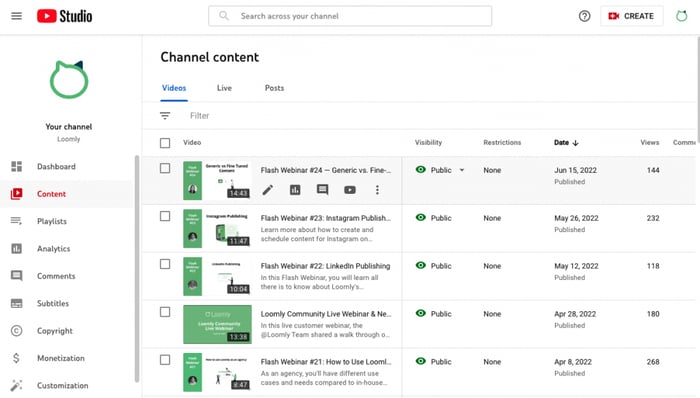
- Pick the video you want to evaluate
- In Analytics, select the Overview or Engagement tab to look at the report
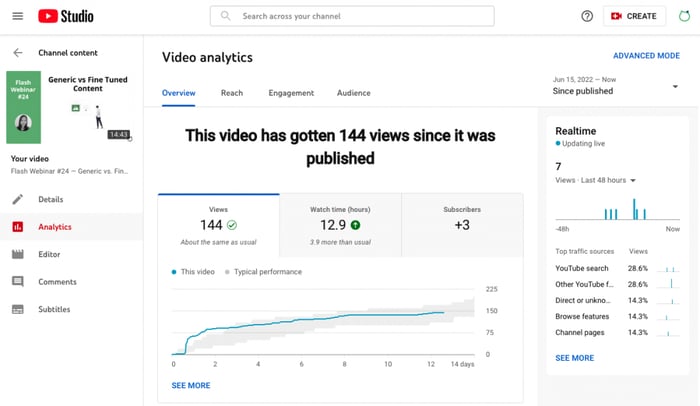
To get a better view of how well you’re doing, you can also compare your audience retention stats for the last 10 videos you’ve published.
2. YouTube Watch Time
Like audience retention, watch time evaluates how long your audience tends to stick around on your channel.
But where audience retention is the percentage of a video users typically watch — so, if users tend to stop at a video’s half-way mark, audience retention is 50% — watch time is the total number of minutes people have spent watching a video since the day it’s been published.
Like audience retention, watch time is hugely important to search rankings.
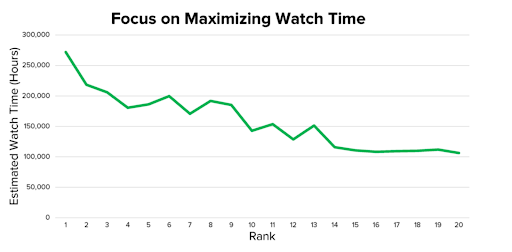
Source: Briggsby
Longer watch times tell YouTube’s algorithm that your content is relevant and engaging. They also signal that your content keeps users on the site for longer. Which, as we’ve mentioned above, is exactly what YouTube wants.
To view individual videos’ watch time stats, head to your YouTube Studio dashboard. Click Analytics, choose a video, and switch to the Overview or Engagement tab.
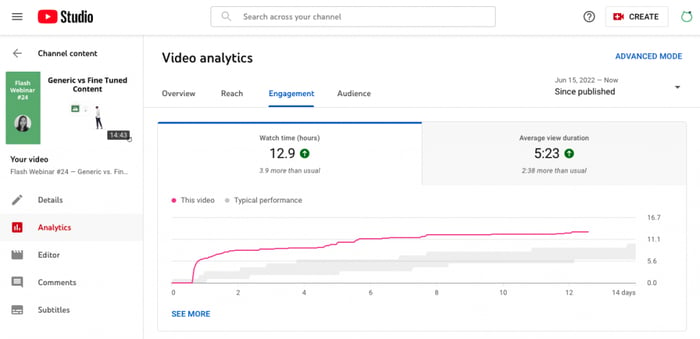
You can see a video’s lifetime views or narrow things down to a specific time frame. To do this, click on the drop down menu at the top right of the screen.
3. YouTube Click-through Rate
Click-through rate is the percentage of users who choose your video over other results when it turns up in search. When users click on your video, this tells the YouTube algorithm they find it relevant. So, a high click-through rate improves your search rankings.
You can check your channel’s overall click-through rate on YouTube Studio by clicking on Analytics, then Reach.
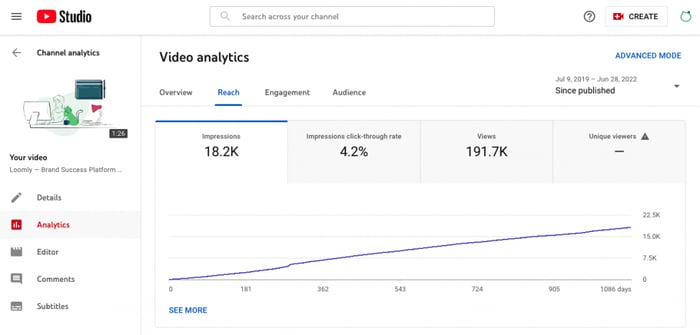
To see the click-through rate for individual videos, go to Content, select the video you want to see stats for, then Analytics, then Reach.
4. YouTube Comments, Shares, and Subscribes
These are three different metrics, but, similar to likes, they’re engagement signals that give all-important social proof to individual pieces of content and to your channel as a whole.
When Backlinko analyzed 1.3 million YouTube videos, it found that videos with high numbers of comments and shares ranked better than similar videos with lower numbers of comments and shares. If users tended to subscribe to the channel after watching a video, that video typically also got a boost in search results.
Comments, shares, and subscribes are also important for another reason: they encourage more people to engage with your content. P.S. Make sure you’re responding!
This is because humans are wired to take their cues from others. Just as nobody wants to be the first one to arrive at a party or hit the dance floor, nobody wants to be the first to leave a comment.
As with other metrics, you can view comments, shares, and subscribes in your YouTube Studio dashboard. To view all your Channel Comments at once, simply select Content from your YouTube Studio dashboard menu, then you can respond directly.
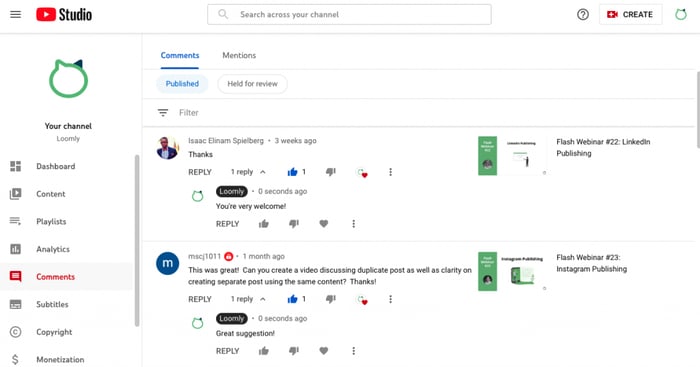
Youtube Analytics, in a nutshell
While you might think likes — to paraphrase an old adage — make YouTube go ’round, the truth is that they’re only one of several factors that affect your visibility. So, it doesn’t matter much that you can’t see who liked a video or comment.
Just as important, you need to make sure you grab — and keep — your audience’s attention and get them to comment, share and subscribe.
How to boost click-through rates, retention, and engagement is a whole topic unto itself. That said, we’ll leave you with these three pieces of advice to get you on the right track.
First — and as obvious as it sounds — make your videos as compelling as possible. Research what your audience wants and give them something relevant, useful, and entertaining.
Second, optimize your videos for search.
While you should avoid clickbait, an enticing headline will encourage more people to watch your video. Similarly, an eye-catching thumbnail will help your video stand out and give users a better idea of what it’s about.
Thirdly, if you want people to engage with your content, give them a reason to do so. Users are more likely to like, comment, and subscribe to your channel if you consistently deliver value.
Want to see how Loomly can help you reach new audiences and build your brand online?
